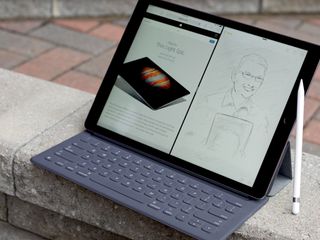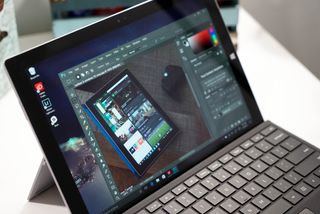How full Photoshop on iPad may help Apple beat Microsoft to the punch (again)
Apple's quest to legitimize the iPad as a post-PC device received a boost from Adobe as full Photoshop is headed to Apple's iOS-powered tablet.

Apple has long existed in Microsoft's shadow in its attempt to position Mac and more recently iOS as alternatives to Windows PC's productivity prowess. iOS is a mobile OS which originated as a smartphone platform in 2007. Over a decade after its debut on the iPhone, it is a much more powerful OS that also powers Apple's tablets.
Combined with industry-leading custom processors and other hardware Apple's OS and hardware synergy is steadily pushing the iPad's productivity capabilities closer to Windows PCs' capabilities. In fact, Adobe noted that its ability to bring full Photoshop to the iPad is a result of what the hardware is now capable of handling compared to its limits of the past.
It's ironic that Apple's goal to position the iPad as a PC competitor is supported by Microsoft's goal to provide a Microsoft experience across all platforms. Office and a host of other Microsoft apps on iOS have enhanced the iPads productivity positioning. Now with full Adobe Photoshop in the mobile mix, Apple's post PC vision seems to be coming to fruition. Sadly, Microsoft's Universal Windows Platform-driven (UWP) post-PC dreams are still quite fruitless by comparison.
Adobe's cross-platform dreams mirror Microsoft's


To be clear, full Adobe Photoshop on the iPad is not about Apple. It is about Adobe's cross-platform vision to bring its products and services to a multitude of platforms. Adobe Project Manager for Photoshop Pam Clark's central message regarding the company's vision was that Adobe was making its products available across platforms beginning with: "a preview of Photoshop on the iPad, but we will gradually add new operating systems and form factors when they are ready."
Though most coverage of this topic focuses only on Photoshop coming to the iPad, the strategy is a much bigger "platform approach" akin to Microsoft's cross-platform strategy which I recently wrote about. Adobe envisions its cross-platform approach as a system where the desktop sits at the center, and all other platforms are peripheral components of the system. Not unlike Microsoft's vision of the PC as the hub with cloud-supported connections to smartphones and other platforms. Clark said it this way:
Photoshop CC on the desktop is the center of the system, and offers unlimited creativity for image compositing, photo editing, designing websites and mobile apps, digital painting, and 3D and AR workflows.Photoshop CC on the iPad is the newest piece of the system, bringing real Photoshop to mobile devices ... People can use the mobile version of Photoshop on its own or as a partner to Photoshop on the desktop.Cloud documents are another new piece that makes PSD files accessible across the system. You can open and edit a PSD on an iPad, open and edit the same PSD on the desktop.
PhotoShop touchable, UWP not so much
It is important to note that PhotoShop on iPad uses the same code base as its desktop counterpart. Adobe asserts that this provides a familiar experience and will allow users to sync between devices easily. The pain point for Microsoft is Adobe for iPad, per Clark, has been designed for a modern touch environment and with natural touch gestures. Microsoft's UWP apps are supposed to do similar things for Microsoft but are off to a woefully slow start.
Part of Microsoft's UWP goal is to modernize legacy apps by beginning with a "conversion process" through its app bridge Project Centennial. In a nutshell, Project Centennial ultimately helps bring the power of legacy apps to a modern form that includes Cortana integration, notifications, an updated touch-friendly UI, inclusion in the Microsoft Store and more. This brings benefits to the modern PC experience on touch-enabled 2-in-1s and future form factors such as Andromeda that can be a phone, tablet, and PC when docked.
Get the Windows Central Newsletter
All the latest news, reviews, and guides for Windows and Xbox diehards.
Sadly, Microsoft's UWP efforts have yet to cross the bridge from an awesome plan to practical reality. Conversely, though we are barely at the beginning of this journey, full Photoshop on the iPad is another step into a reality where the full power of popular productivity apps may become commonplace on touch-centric mobile form factors.
With the world's most popular productivity suite, Office, and now the world's most popular image editing software, Photoshop, on the world's most popular tablet PC, iPad, Apple is even better positioned to lay claim to its post-PC vision.
UWP Q & A with Microsoft's Stefan Wick
Microsoft's Surface gets so much right but...

Microsoft's hardware efforts with Surface, the industry's embrace of touch-enabled 2-in-1s, the evolution of Windows Ink and Microsoft's success with creating a universal platform position the company to succeed with a modern post-PC vision. The plan's execution, however, seems to be Microsoft's Achilles Heel.
Touch is an essential aspect of modern, always-connected mobile computing. And though Windows 10's Tablet Mode is lacking, and UWP apps are sparse Microsoft's 2-in-1 focus pushes touch and inking to the forefront. Anecdotally, I use a combination of touch, keyboard, touchpad, and mouse to move content, select data and more even when using my Surface Pro in Laptop Mode. Perhaps I'm in the minority, but the natural interaction of touching content while working in Laptop Mode combined with doing the same when my Surface is in Tablet Mode seems to show that Microsoft has a significant part of the modern mobile computing experience right.
Sadly, with UWP lagging, Apple's progress with full Photoshop and more on the iPad highlights how much of the modern computing experience Microsoft is still getting wrong. If Microsoft doesn't get it soon, it may find itself edited out of parts of the picture as it was as with smartphones.
Jason L Ward is a columnist at Windows Central. He provides unique big picture analysis of the complex world of Microsoft. Jason takes the small clues and gives you an insightful big picture perspective through storytelling that you won't find *anywhere* else. Seriously, this dude thinks outside the box. Follow him on Twitter at @JLTechWord. He's doing the "write" thing!
